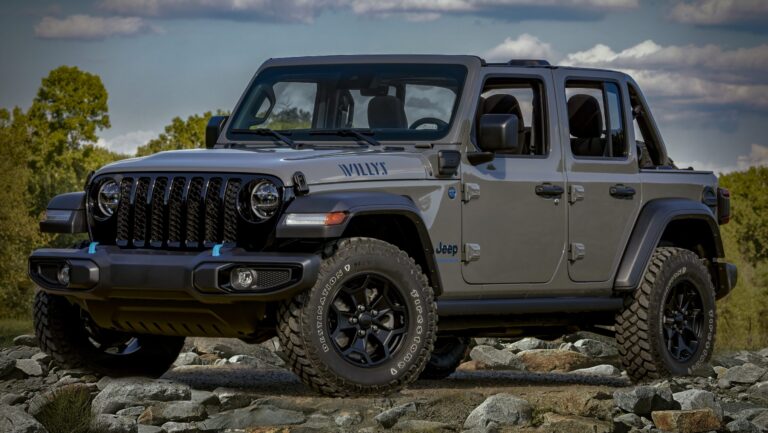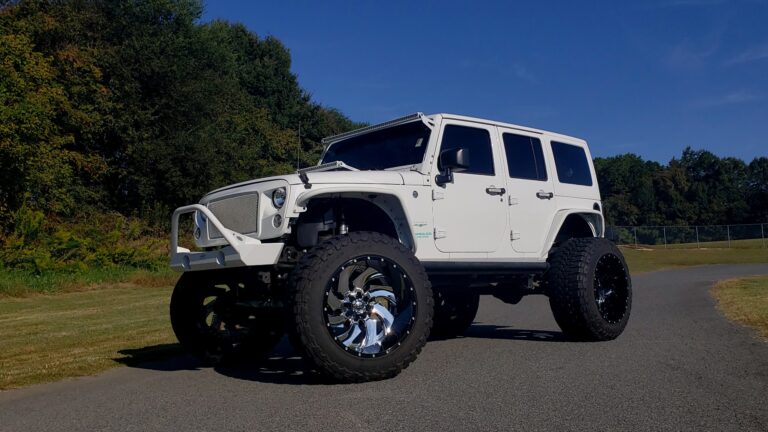1984 Jeep Scrambler For Sale: Your Ultimate Guide to Owning a Legend
1984 Jeep Scrambler For Sale: Your Ultimate Guide to Owning a Legend jeeps.truckstrend.com
The mere mention of "Jeep Scrambler" evokes images of rugged individualism, classic Americana, and unbridled adventure. Among these iconic vehicles, the 1984 Jeep Scrambler, officially known as the CJ-8, holds a particularly special place. More than just a utility vehicle, it’s a tangible piece of automotive history, a long-wheelbase anomaly that blended the go-anywhere capability of the legendary CJ series with the practicality of a small pickup truck. For enthusiasts and collectors alike, finding a 1984 Jeep Scrambler for sale isn’t just a transaction; it’s an opportunity to acquire a rare and increasingly valuable classic. This comprehensive guide will navigate you through everything you need to know about purchasing and appreciating this unique off-road icon.
The Enduring Appeal of the 1984 Jeep Scrambler
1984 Jeep Scrambler For Sale: Your Ultimate Guide to Owning a Legend
The Jeep Scrambler (CJ-8) was produced for a relatively short period, from 1981 to 1986, making it significantly rarer than its CJ-7 sibling. The 1984 model year falls right in the heart of its production, potentially benefiting from earlier design refinements while still retaining the pure, unadulterated CJ DNA. What sets the Scrambler apart is its extended 103.5-inch wheelbase (compared to the CJ-7’s 93.5 inches), which provided a longer rear cargo area, effectively a small pickup bed. This unique configuration made it incredibly versatile, appealing to those who needed more utility than a standard CJ could offer, without sacrificing the open-air, removable-top experience.
Its classic boxy lines, round headlights, and slotted grille are instantly recognizable as part of the golden age of Jeep. Today, the Scrambler’s rarity, combined with its robust off-road capability and undeniable retro cool factor, has driven its desirability and, consequently, its market value. Owning a 1984 Scrambler means joining an exclusive club of enthusiasts who appreciate its blend of utility, heritage, and pure driving joy.
What to Look For: Essential Considerations When Buying
When you’re actively searching for a 1984 Jeep Scrambler for sale, a thorough inspection is paramount. These vehicles are nearly 40 years old, and their lives often involved hard work and exposure to the elements.
- Body and Frame Integrity: Rust is the arch-nemesis of vintage Jeeps. Pay meticulous attention to the frame, particularly where the body mounts, and check for any signs of rot, especially near the rear shackle mounts, spring hangers, and skid plate areas. On the body, inspect floor pans, rocker panels, fenders (front and rear), the tailgate, and the windshield frame. Look for excessive bondo or poor patch jobs, which can hide significant corrosion.
- Engine Options and Condition: The most common engine in a 1984 Scrambler is the venerable 4.2-liter (258 cu in) inline-six, known for its torque and reliability, though carburetor issues can arise. A smaller 2.5-liter (150 cu in) inline-four was also available, and very rarely, the 5.0-liter (304 cu in) V8. Check for oil leaks, unusual noises, smoke from the exhaust, and overall engine performance. Ask for service records to verify maintenance history.
- Transmission and Drivetrain: Manual transmissions (T4, T5) and automatic (TF999) were offered. Test drive to ensure smooth shifting, no grinding, and proper clutch engagement. Engage 4-wheel drive high and low to confirm the Dana 300 transfer case functions correctly. Listen for clunks or excessive play in the universal joints, driveshafts, and differentials (Dana 30 front, AMC 20 rear).
- Suspension and Steering: Worn leaf springs can lead to a saggy ride and poor handling. Check shocks for leaks, and inspect all steering components (tie rods, drag link, steering box) for play. Power steering, if equipped, should operate smoothly without whining.
- Interior and Electrical: While interiors are relatively spartan, check the condition of seats, dashboard, and gauges. Test all lights, wipers, heater, and any aftermarket accessories. Electrical gremlins are common in older vehicles, so ensure all critical systems are functional.
- Documentation and History: A clear title is non-negotiable. Request service records, receipts for parts, and any information about previous owners or significant modifications. A VIN check can reveal accident history or discrepancies.
- Modifications: Many Scramblers have been modified. Assess the quality of any lifts, engine swaps, or aftermarket additions. Well-executed modifications can add value and functionality, but poorly done ones can create headaches and detract from originality.


Types of 1984 Scramblers on the Market
The condition and modification level of a 1984 Jeep Scrambler for sale can vary wildly, directly impacting its price and suitability for your needs.
- Bone Stock/Original: These are the rarest and often command the highest prices, especially if they are low-mileage or exceptionally well-preserved. They are ideal for collectors seeking an investment or those who desire an authentic experience, but may require significant reconditioning of original components.
- Lightly Modified/Restored: This is a common category, featuring vehicles that have undergone some level of restoration (paint, interior, minor mechanicals) or light modifications (small lift, upgraded tires). They offer a good balance of classic appeal and modern usability. Carefully scrutinize the quality of the restoration work.
- Heavily Modified/Off-Road Rig: These Scramblers have often been transformed into dedicated off-road machines with larger lifts, custom axles, engine swaps, and reinforced components. While excellent for extreme trails, they might not be suitable for daily driving or purist collectors. Their value is highly dependent on the quality and reputation of the components used.
- Project Vehicle: The most affordable entry point, project Scramblers require significant time, money, and mechanical skill. They might be non-running, have extensive rust, or be incomplete. Be realistic about the total cost and effort involved before committing to a project.

The Buying Process: Practical Advice and Actionable Insights
Purchasing a classic like the 1984 Jeep Scrambler requires a strategic approach.
- Setting a Realistic Budget: Beyond the purchase price, factor in potential restoration costs, immediate maintenance, insurance (consider classic car insurance), and registration fees. A "good deal" on a cheap Scrambler can quickly become an expensive nightmare if it needs extensive work.
- Where to Search: Online marketplaces like Bring a Trailer, eBay Motors, Hemmings, and dedicated Jeep/CJ forums are excellent starting points. Facebook Marketplace and local classifieds can also yield hidden gems. Reputable classic car dealerships specializing in 4x4s may also have Scramblers, often at a higher price but potentially with more rigorous inspections.
- Pre-Purchase Inspection (PPI): This is non-negotiable. If you’re not an expert in vintage Jeeps, hire a qualified mechanic specializing in older 4x4s to perform a thorough inspection. A PPI can uncover hidden issues and save you thousands in future repairs.
- Negotiation: Be informed about the market value based on condition and originality. Don’t be afraid to negotiate, especially if the PPI uncovers issues. Be prepared to walk away if the price isn’t right or the seller is unwilling to address concerns.
- Transportation: If you’re buying remotely, factor in the cost and logistics of shipping the vehicle. Ensure the seller is cooperative with your transport arrangements.
Ownership and Maintenance: Tips for Your Scrambler
Owning a 1984 Jeep Scrambler is a rewarding experience, but it comes with its own set of responsibilities.
- Common Issues: Be prepared for common issues like rust re-emergence (even after repair), carburetor tuning (especially on the 4.2L), minor fluid leaks, and occasional electrical quirks.
- Parts Availability: Fortunately, many mechanical parts are interchangeable with the more common CJ-7 and early Wrangler (YJ) models, making them relatively easy to source. Body panels specific to the Scrambler’s longer wheelbase (like the bed and longer hardtop) can be harder to find and more expensive.
- Community Support: The Jeep community is vast and incredibly supportive. Online forums, Facebook groups, and local Jeep clubs are invaluable resources for technical advice, parts sourcing, and general camaraderie.
- Insurance: Explore classic car insurance options, which often offer better coverage and lower premiums for vehicles that are not daily drivers and have appreciating value.
- Value Appreciation: A well-maintained, original, or professionally restored Scrambler is likely to continue appreciating in value. Keep detailed records of all maintenance and restoration work.
1984 Jeep Scrambler For Sale: Estimated Price Guide
The price of a 1984 Jeep Scrambler can vary significantly based on its condition, originality, and location. This table provides a general estimate.
| Condition Category | Estimated Price Range (USD) | Key Characteristics |
|---|---|---|
| Project Vehicle | $5,000 – $15,000 | Non-running, significant rust, major mechanical issues, incomplete, requires full restoration. High effort/cost. |
| Fair Condition | $15,000 – $25,000 | Running but needs extensive work (rust repair, mechanical overhaul, paint, interior). Driveable but far from perfect. |
| Good Condition | $25,000 – $40,000 | Solid runner, minimal rust (surface only), decent paint, functional interior. May need minor cosmetic or mechanical fixes. |
| Excellent/Restored | $40,000 – $65,000+ | Professional restoration, strong mechanics, minimal to no rust, good paint, clean interior. Ready to drive and show. |
| Concours/Collector-Grade | $65,000 – $90,000+ | Flawless, highly original or meticulously restored to factory specifications. Low mileage, impeccable provenance. |
Note: These are estimates and market conditions, specific modifications, and geographic location can influence actual prices.
Frequently Asked Questions (FAQ) about the 1984 Jeep Scrambler
Q1: Why is the 1984 Jeep Scrambler so popular and often expensive?
A1: Its popularity stems from its unique long-wheelbase design, rarity (short production run compared to CJ-7), classic CJ styling, and strong off-road capability. Its increasing value is due to its collector status as a highly sought-after vintage 4×4.
Q2: What’s the main difference between a Scrambler (CJ-8) and a CJ-7?
A2: The primary difference is the wheelbase length. The Scrambler has a 103.5-inch wheelbase, 10 inches longer than the CJ-7’s 93.5 inches. This extra length provides a longer rear cargo area, giving the Scrambler its distinctive small pickup truck appearance.
Q3: Are parts hard to find for a 1984 Scrambler?
A3: Mechanical parts (engine, transmission, drivetrain components) are generally available due to interchangeability with CJ-7s and early Wranglers (YJs). However, body panels specific to the Scrambler’s unique length (like the rear bed, longer soft/hard tops) can be more challenging and expensive to source.
Q4: What’s the best engine option for a 1984 Scrambler?
A4: The 4.2-liter (258 cu in) inline-six is generally considered the best original engine due to its robust torque and reliability. While not a powerhouse, it’s well-suited for off-roading and cruising. Many owners opt for modern fuel injection conversions to improve reliability and performance.
Q5: Can I use a 1984 Scrambler as a daily driver?
A5: While possible, it’s generally not recommended for a stock Scrambler. Older Jeeps lack modern safety features, comfort, and fuel efficiency. They require more frequent maintenance and are best enjoyed as weekend cruisers, off-roaders, or collector vehicles. A heavily modified Scrambler might be more daily-driver friendly, but often at the cost of originality.
Q6: What should I look for to avoid buying a "money pit" Scrambler?
A6: The biggest indicators of a money pit are extensive rust in the frame and critical body areas, a non-running or severely damaged engine/transmission, or a title that isn’t clear. A pre-purchase inspection by a trusted mechanic is the best way to uncover hidden issues and avoid costly surprises.
Conclusion
The 1984 Jeep Scrambler is more than just a vintage 4×4; it’s a testament to a bygone era of utilitarian design and adventurous spirit. For those seeking a vehicle that blends classic looks with genuine off-road prowess and a touch of pickup truck utility, the Scrambler stands alone. While finding a well-preserved example requires patience and a keen eye, the reward of owning such a unique and iconic machine is immeasurable. Whether destined for the trail, the show circuit, or simply cruising with the top down, a 1984 Jeep Scrambler for sale represents an opportunity to invest in a piece of automotive legend that promises not just a ride, but an experience.






